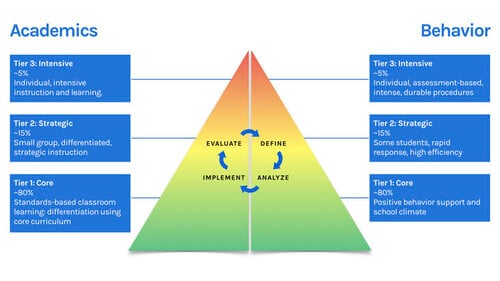What is Tier 1 in Response to Intervention (RTI) / Multi Tiered System of Supports (MTSS)?
At Tier 1, all students receive scientific, research-based core instruction implemented with integrity and emphasizing grade-level standards and school-wide behavioral expectations. Instruction at Tier 1 should be explicit, differentiated and include flexible grouping and active student engagement. To ensure 80% of students’ needs are met at Tier 1, high quality instruction is essential. Features of high quality, research-based instruction include (Chard et al., 2008):

-
Standards-Based Curriculum: a curriculum based upon the Common Core State Standards (or district standards).
-
Systematic Explicit Instruction: Skills are taught from less to more complex using direct, clear and concise instructional language.
-
Differentiated Instruction: students have different levels of background knowledge and school readiness. Differentiated instruction engages each student in active learning according to his/her needs. The content of instruction, delivery of instruction, and targeted level of instruction can be differentiated.
-
Flexible Grouping: a combination of whole group, small group, and individual instruction allows teachers to create fluid groups that meet the needs of all students.
-
Active Student Engagement: ensuring all students are actively involved during instruction and are not passive recipients. This can be accomplished with high rates of opportunities to respond, ample time to practice skills, and prompt corrective feedback.
-
Classroom Behavior Strategies: proactively and explicitly teaching the expected behaviors and routines, frequent use of reinforcement and praise (4:1 positive to negative feedback loop), quick and efficient transition times, and consistent instructional response to misbehavior.
A solid MTSS / RTI Tier 1 should be sufficient to help 80% of students meet or exceed grade level expectations as measured by a standardized summative assessment. If Tier 1 instruction is not successful in meeting the needs of 80% of the school’s population, the school team should consider possible solutions to create a better match between students’ needs and the core curriculum and instruction (e.g., improving explicit instruction, differentiation strategies, use of flexible grouping, and maximizing active student engagement).
It’s critical that any comprehensive Response to Intervention solution or Multi Tiered System of Supports solution address student populations at all tiers, including tier 1.